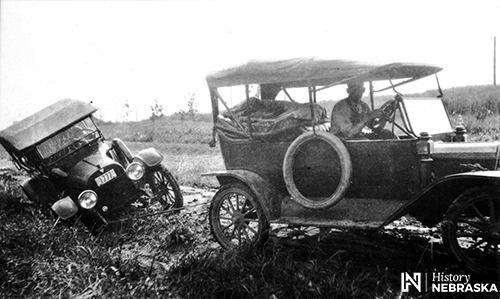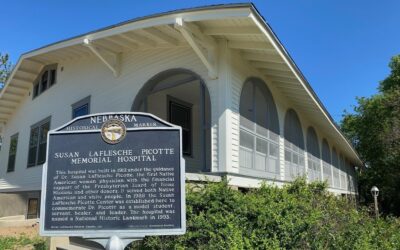
Stuck in the mud near Bancroft, Nebraska. NSHS RG3334-1-56
It’s small consolation if you ever get stuck in the mud, but the fact is Nebraska has come a long way since pioneer times in the development of its public roads and highways. A glance through pioneer reminiscences and the spring issues of early newspapers provides plenty of evidence that good old-fashioned Nebraska mud was one of the principal obstacles in the way of spring travel here.
Covered wagon emigrants, beating their way to Oregon, California, or Utah, frequently had trouble with the muddy Nebraska leg of the long journey, almost always undertaken in early spring. The trails became so badly rutted that wagons could not pass, and new roads had to be marked out. This accounts in part for the fact that the Oregon Trail may be several miles wide in certain parts of the state, notably southeastern Nebraska.
In territorial times, roads were little better than trails and when the ground thawed out in the spring they usually were impassable. Rural roads were not the only ones afflicted by the spring thaw. Villages and city streets suffered in equal or greater proportion.
An editorial in the Dakota City Democrat, April 13, 1861, may be considered typical: “Last week this city was visited by shower after shower of April rain that reduced the condition of our streets to the consistency of paste. Pedestrians worked them up into a still worse condition . . . until the upper surface for two feet deep, was of the primitive nature of brick. Stilts, and other pedal appendages, adroit jumping, and the aquatic knowledge of sturgeons, were in much requisition.”
Even the proud city of Omaha was afflicted with mud. The Omaha Daily Bee, on May 28, 1881, reported that a team of horses pulling a grocery wagon had recently been rescued from a mudhole near Fourteenth and Douglas streets. An unsuccessful attempt to eliminate the hole had been made by city workmen, who filled it with soft mud and then smoothed dirt over the top.
But when a team of horses “touched the reconstructed mudhole, they sunk to their shoulders in soft mire. The efforts which they made to get out only sunk them deeper . . . . After struggling in the pit for about an hour a sufficient crowd collected to raise one of the horses bodily and remove it to firm ground. The other horse was taken out after much difficulty. It was badly strained in the process and its harness nearly ruined.” The Bee noted, “The matter created considerable indignation.”
– Patricia C. Gaster, Assistant Editor / Publications



